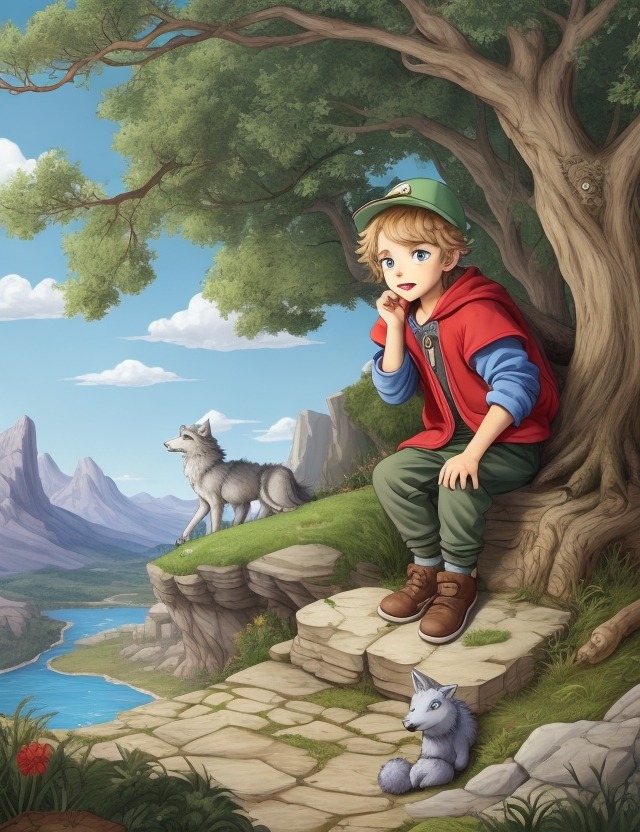In the annals of storytelling, few tales have resonated as profoundly as the classic parable of The Boy Who Cried Wolf. Passed down through generations, this time-honored fable captures the essence of human nature, imparting invaluable wisdom in a simple yet compelling manner. Penned by an anonymous author long ago, this tale has transcended time to become a cultural touchstone, evoking curiosity and captivating audiences of all ages.
As we embark on this literary journey together, prepare to unearth the intrigue surrounding The Boy Who Cried Wolf. Discover how this seemingly innocent tale continues to captivate minds across generations, and how its teachings remain as essential today as they were when first brought to life. So, let us delve into the fascinating world of the boy and the wolf while unraveling the profound life lessons that lie within.
The Boy who Cried Wolf: Book Summary
The boy who cried wolf short story summary. Once upon a time in a small village, there lived a mischievous young boy named Peter. Peter had a habit of playing pranks on everyone, even his parents! But his favorite target was the villagers, whom he loved to startle and make look foolish. He was known for his cunning ways but little did he know that his tricks would teach him a valuable lesson.
One sunny day, while Peter was tending to his sheep in the meadows, he started to feel mischievous. His mischievousness often got the better of him, and an idea popped into his head. He thought, “Wouldn’t it be fun to see the villagers panic and rush to my rescue, thinking there’s a wolf attacking my sheep?” Grinning widely, Peter put his plan into action.
He climbed to the top of a steep hill and famously shouted, “Wolf! Wolf! Help!”
Hearing his cry, the villagers hastily dropped their work and rushed towards the meadow, hoping to save Peter’s sheep from the menacing wolf. But as they reached the meadow, they discovered Peter laughing heartily.
“Foolish villagers!” he giggled. “There is no wolf here!” The villagers felt frustrated but decided to give him a second chance, believing that he would learn his lesson.
The next day, Peter decided it was time for another prank. He climbed back up the hill and shouted, “Wolf! Wolf! Help!”
Once again, the villagers, believing Peter was truly in danger this time, rushed to his aid. But when they arrived, they found Peter laughing again and exclaimed, “You tricked us again, Peter! This is not funny!”
Peter shrugged and skipped away, thinking he had outsmarted them once more. Little did he know that his actions were leading him down a path that he would soon regret.
Days turned into weeks, and Peter continued to play tricks on the villagers. He laughed each time, finding great amusement in their reactions. But one day, when Peter was least expecting it, a real wolf appeared in the meadow.
Panicking, Peter screamed, “Wolf! Wolf! Help!” But this time, the villagers had grown tired of his pranks. They believed it was yet another trick and chose not to respond.
The wolf growled and approached Peter’s sheep, devouring one after another. Peter realized his mistake and understood that the villagers no longer trusted him. Tears streamed down his face as he shouted for help, but it was too late. The wolf disappeared into the forest, leaving Peter sobbing and regretful for his foolish behavior.
The next day, the villagers gathered for a meeting. They discussed how Peter’s lies had endangered not only his sheep but potentially their own lives as well. They decided to give him one final chance to redeem himself.
They summoned Peter and explained, “Peter, your actions have consequences. We can no longer trust you because of your lies. We understand that you enjoy playing pranks, but this is a serious matter. From now on, you will be responsible for keeping watch over the sheep but under strict supervision. If you prove that you can be honest and trustworthy, we might regain our faith in you.”
Peter nodded somberly, realizing the severity of his actions. He accepted the villagers’ terms and promised to change his ways.
Days turned into weeks once again, and Peter carried out his duties diligently. He realized the importance of trust and how his lies had caused irreparable damage. He took this opportunity to reflect and understand that trust is earned through honesty and responsible actions.
Over time, the villagers noticed a significant change in Peter’s behavior. They saw his sincerity and dedication towards his newfound responsibility. Slowly but surely, they began to trust him again. Peter cared for his sheep with great devotion, never allowing any harm to come their way.
Years passed, and Peter became a respected member of the community. He had learned his lesson well and was admired for his honesty and hard work. People often sought his advice and guidance on various matters.
And so, the boy who cried wolf had transformed into the boy who learned the power of trust and the weight of his words. Peter had grown into a responsible young man and remained a cherished member of the village until his last days.
The story of the boy who cried wolf teaches us the importance of honesty, trust, and accountability. It reminds us that our actions have consequences, and playing tricks on others can lead to loss of trust and jeopardize relationships. It encourages us to be sincere, reliable, and to take responsibility for our words and actions.
Remember, dear children, trust is a priceless virtue, and once broken, it takes a lot of effort and time to rebuild. So let us always be honest and genuine, just like the reformed boy, Peter, who learned the hard way and earned back the trust of his village.
The Boy Who Cried Wolf Moral Lessons
The story of “The Boy Who Cried Wolf” is a classic fable that teaches us about the importance of honesty and trust. Here are three important lessons we can learn from it:
- Honesty is the best policy: The boy in the story repeatedly lied to the villagers about the presence of a wolf, which led to them not believing him when a wolf actually appeared. The story teaches us that honesty is always the best policy, and that lying can have serious consequences.
- Trust is earned: The villagers in the story stopped trusting the boy because he had lied to them so many times. The story teaches us that trust is something that must be earned, and that it can be lost if we are not truthful.
- Actions have consequences: The boy’s lies had serious consequences when a wolf actually appeared, and no one believed him. The story teaches us that our actions have consequences, and that we must be prepared to face them.
Key Theme for The Boy who Cried Wolf
The Boy Who Cried Wolf is a well-known fable that originated from Aesop’s fables and has been retold in numerous versions. The story follows a young shepherd boy who repeatedly tricks the villagers by falsely shouting “wolf” to get attention. Eventually, when a real wolf appears and the boy cries out for help, the villagers no longer believe him, and he pays the consequences for his dishonesty.
- The Consequences of Dishonesty: One of the prominent themes of “The Boy Who Cried Wolf” is the repercussions and consequences of dishonesty. The boy’s repeated false alarms erode the trust and credibility he once had with the villagers. This fable teaches the important lesson that lying and deceiving others can lead to severe negative consequences, as people may no longer believe or trust you when you are truly in need.
- The Importance of Trust: Trust is fundamental in any relationship, whether it is between friends, family, or communities. In “The Boy Who Cried Wolf,” the shepherd boy loses the trust of the villagers due to his deceitful behavior. This theme highlights the significance of trust and how easily it can be shattered by dishonesty. Without trust, relationships and communities can crumble, emphasizing the importance of honesty and integrity.
- The Power of Accountability: Another theme present in this fable is the concept of accountability. When the villagers no longer believe the boy’s cries for help, he is left to face the real danger of the wolf on his own. This serves as a reminder that we are responsible for our actions and should be prepared to face the consequences. It encourages individuals to take ownership of their behavior and understand that being deceitful or dishonest can have severe repercussions on themselves and others.
Overall, “The Boy Who Cried Wolf” imparts valuable lessons about the consequences of dishonesty, the importance of trust, and the power of accountability. These themes emphasize the significance of honesty, integrity, and the potential damage that can be caused by falsehoods, ultimately urging individuals to act with honesty and integrity in their own lives.
The boy who cried Wolf: Characters
1. The Boy:
– The central character of the story, a mischievous young boy with a flair for drama.
– Known for his vivid imagination and tendency to exaggerate.
– Physically, he is a small, wiry child with bright, mischievous eyes and a lightning-fast grin.
– He is always found wearing tattered jeans and a faded red cap that perpetually sits askew on his head.
– Funny data: He has an uncanny ability to imitate the sound of a wolf howling, which leaves everyone in awe, but is also a source of frustration for those around him.
2. The Sheep:
– A flock of innocent, woolly sheep who graze peacefully in the meadows.
– Easily alarmed and prone to panic, they are the main victims of the boy’s pranks.
– They have soft, fluffy wool that changes shades from pristine white to warm shades of caramel.
– Often found huddled together for safety, their large, round eyes gaze nervously at every sound.
– Funny data: One particularly quirky sheep prefers to munch on dandelions all day, earning its nickname, “Dandy.”
3. The Villagers:
– Diligent, hardworking individuals who live in a close-knit farming community.
– A medley of characters, ranging from the blacksmith and the baker to the gossip-loving tailor.
– Dressed in an array of outfits, from overalls splattered with mud to aprons dusted with flour, reflecting their diverse occupations.
– Always on high alert due to the boy’s constant calls for help, yet deeply loyal to their neighbors.
– Funny data: The baker secretly harbors a passion for watercolor painting and often snags farm-fresh eggs to use as paint palettes while the chickens aren’t looking.
4. The Wise Old Man:
– An elder gentleman whose wisdom is highly respected within the village.
– Sporting a long, flowing gray beard and a twinkle in his eyes, no one questions his guidance.
– Known for his patience in dealing with the boy’s shenanigans, offering sage advice.
– Often found sitting atop a wise old oak tree stump, deep in thought, with a pet squirrel named Nutmeg perched on his shoulder.
– Funny data: The old man is an excellent whistler and can mimic the songs of a variety of birds, which he uses to woo his Nutmeg.
5. The Wolf:
– The elusive antagonist of the story, a cunning predator who occasionally lurks near the village.
– Cloaked in a thick coat of sleek gray fur, his piercing amber eyes strike fear into the hearts of both animals and humans.
– Mysteriously quiet, the wolf often prowls silently through the woods, blending seamlessly into the night.
– Encounters with the wolf are rare, adding an element of genuine danger to the boy’s repeated false alarms.
– Funny data: Despite his fierce reputation, the wolf has a hidden talent for harmonizing, and his howls often come out in melodious sequences, leaving everyone bewildered.
The boy who cried Wolf: Symbols
1. The Wolf: The wolf is a powerful and predominant symbol in the book “The Boy Who Cried Wolf.” It represents danger, threat, and the consequences of dishonesty. Throughout the story, the boy repeatedly fabricates sightings of a wolf to gain attention and excitement. However, when a real wolf eventually appears and the boy cries for help, nobody believes him due to his history of false alarms. The wolf symbolizes the boy’s misuse of trust and the importance of honesty. It serves as a cautionary symbol, reminding readers of the potential consequences of lying and the significance of credibility.
2. The Shepherd’s Trust: In the book, the shepherd represents a figure of trust and authority. The boy is initially trusted with the responsibility of guarding the sheep, and the shepherd entrusts him with this task. However, as the boy repeatedly cries wolf to deceive others, he loses the shepherd’s trust. The shepherd’s trust is symbolic of the trust others place in us. When the boy betrays this trust, it demonstrates the detrimental impact that dishonesty can have on relationships and reputations. It serves as a reminder to value the trust given to us by others and uphold it with honesty and integrity.
3. The Townspeople’s Perception: The townspeople in the book represent a collective symbol for society or community. Through their response to the boy’s false alarms, the book highlights the issue of credibility and the importance of being cautious in accepting information. Initially, the townspeople respond to the boy’s cries for help, indicating their willingness to support and protect one another. However, as the boy continues to deceive them, they become skeptical and disregard his pleas, leading to disastrous consequences. This symbolizes how society can be deceived by dishonesty and highlights the need for critical thinking and discernment. It emphasizes the significance of not taking important matters lightly and emphasizes the value of trust and reliability in a community.
The boy who cried Wolf: Culture Impact
“The Boy Who Cried Wolf” is not just another children’s fable; it has become an iconic piece of literature that has left a lasting impact on our culture. Since its inception in ancient Greece, this timeless tale has infiltrated various aspects of our society, leaving behind a trail of historic data, laughter, and noteworthy achievements.
Dating back to the 6th century BCE, “The Boy Who Cried Wolf” was first mentioned by the famous Greek storyteller, Aesop. This fable found its place among his collection of moral tales, primarily aimed at teaching children valuable life lessons. However, it was not until the 17th century that its popularity skyrocketed with its inclusion in the renowned compilation of Aesop’s fables by Roger L’Estrange. From that point onwards, this seemingly simple tale would continuously influence and shape our cultural landscape.
One of the notable impacts of “The Boy Who Cried Wolf” lies in its ability to impart a valuable lesson about honesty and integrity. Through the boy’s repeated false alarms about the wolf, readers and listeners alike learn the consequences of lying and the importance of trustworthiness. This core message has reverberated throughout generations, highlighting the power of truthfulness and shattering the notion that deceit can bring any kind of beneficial outcome.
Humor has also played a significant role in the cultural impact of this fable. The irony of the boy’s cries for help and the subsequent lack of response from the villagers has been a source of laughter and amusement for centuries. The absurdity of his actions, coupled with the villagers’ eventual indifference to his pleas, adds a touch of comedic relief to this cautionary tale. Humor, it seems, can be an effective tool in conveying important life lessons and capturing the imagination of both young and old.
“The Boy Who Cried Wolf” has achieved a remarkable level of prominence and recognition. It has transcended cultural boundaries, being translated into countless languages and adapted into various forms of media, including books, movies, theatrical productions, and cartoons. This widespread adaptation has exposed millions to its timeless message, allowing it to reach and impact generations far beyond its original Greek origins.
Furthermore, this fable has significantly influenced our literary landscape, serving as a source of inspiration for countless other stories and works. Its depiction of a young boy learning the hard way the importance of honesty has become a recurring theme in children’s literature. Authors and writers have drawn upon its message of integrity in creating relatable characters and stories, cementing its legacy as a classic and enduring tale.
In conclusion, “The Boy Who Cried Wolf” has left an indelible mark on our culture. Its historic origins, ability to evoke laughter, and notable achievements have ensured its place in the annals of literature. From imparting life lessons to sparking imaginations and creativity, this fable continues to shape the values and beliefs of successive generations. It serves as a timeless reminder that truthfulness and integrity are virtues worth cherishing and practicing throughout our lives.
FAQs
- Who is the author of the book The Boy Who Cried Wolf?
The author of the book “The Boy Who Cried Wolf” is Aesop. - Is The Boy Who Cried Wolf a children’s book?
Yes, “The Boy Who Cried Wolf” is a popular children’s fable that teaches the lesson of honesty and integrity. - What is the story of The Boy Who Cried Wolf about?
The story revolves around a young shepherd boy who repeatedly tricks the villagers by falsely claiming that a wolf is attacking his flock. When a real wolf actually appears and he cries for help, the villagers do not believe him, and the boy suffers the consequences of his dishonesty. - What is the moral of The Boy Who Cried Wolf?
The moral of the story is that lying has consequences and being truthful is important. It emphasizes the importance of credibility and integrity. - Is The Boy Who Cried Wolf based on a true story?
No, “The Boy Who Cried Wolf” is a fictional story created by Aesop to teach a moral lesson. It is not based on any actual events.










